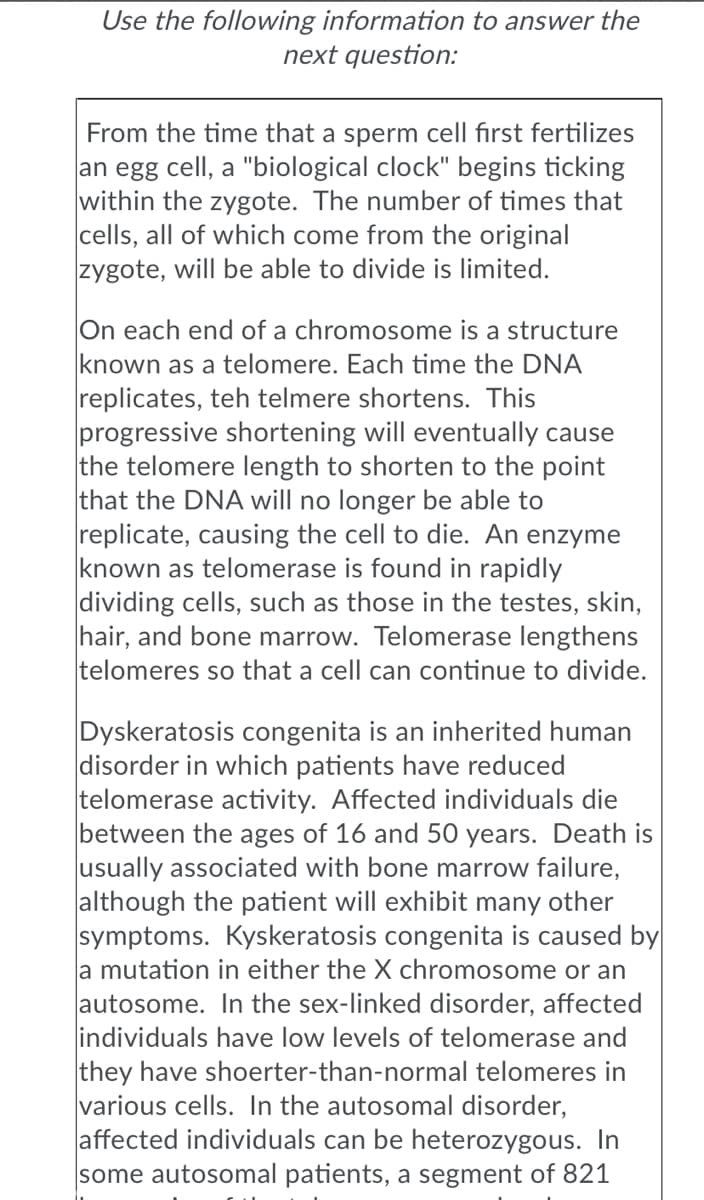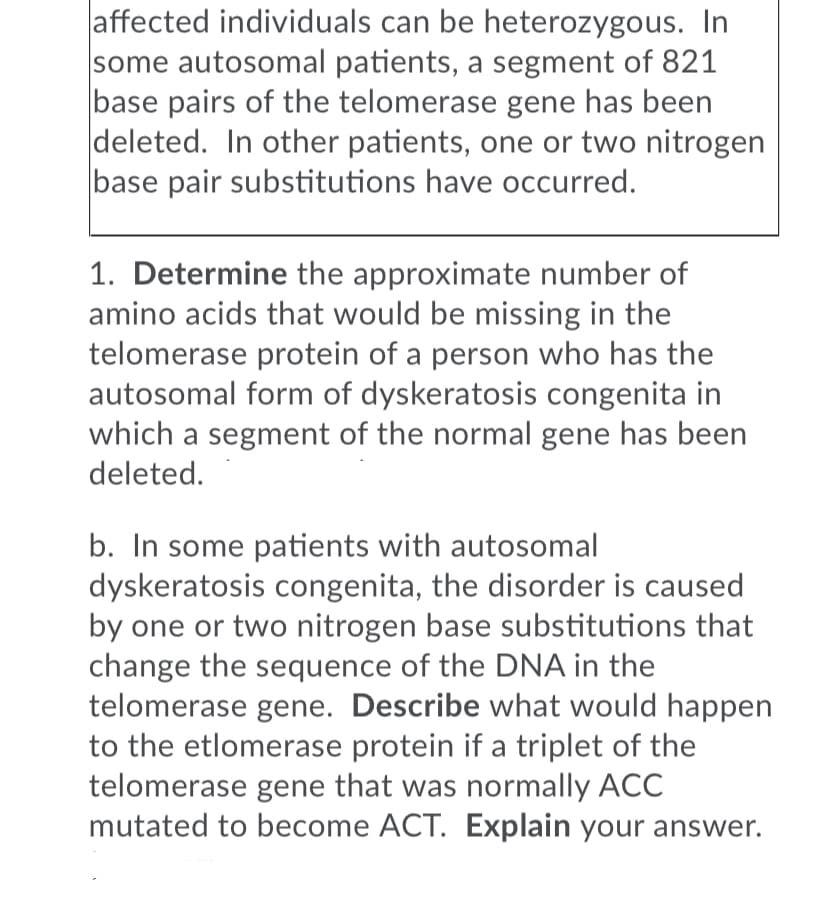1. Determine the approximate number of amino acids that would be missing in the telomerase protein of a person who has the autosomal form of dyskeratosis congenita in which a segment of the normal gene has been deleted.
1. Determine the approximate number of amino acids that would be missing in the telomerase protein of a person who has the autosomal form of dyskeratosis congenita in which a segment of the normal gene has been deleted.
Human Anatomy & Physiology (11th Edition)
11th Edition
ISBN:9780134580999
Author:Elaine N. Marieb, Katja N. Hoehn
Publisher:Elaine N. Marieb, Katja N. Hoehn
Chapter1: The Human Body: An Orientation
Section: Chapter Questions
Problem 1RQ: The correct sequence of levels forming the structural hierarchy is A. (a) organ, organ system,...
Related questions
Question
Please answer both parts

Transcribed Image Text:Use the following information to answer the
next question:
From the time that a sperm cell first fertilizes
an egg cell, a "biological clock" begins ticking
within the zygote. The number of times that
cells, all of which come from the original
zygote, will be able to divide is limited.
On each end of a chromosome is a structure
known as a telomere. Each time the DNA
replicates, teh telmere shortens. This
progressive shortening will eventually cause
the telomere length to shorten to the point
that the DNA will no longer be able to
replicate, causing the cell to die. An enzyme
known as telomerase is found in rapidly
dividing cells, such as those in the testes, skin,
hair, and bone marrow. Telomerase lengthens
telomeres so that a cell can continue to divide.
Dyskeratosis congenita is an inherited human
disorder in which patients have reduced
telomerase activity. Affected individuals die
between the ages of 16 and 50 years. Death is
usually associated with bone marrow failure,
although the patient will exhibit many other
symptoms. Kyskeratosis congenita is caused by
a mutation in either the X chromosome or an
autosome. In the sex-linked disorder, affected
individuals have low levels of telomerase and
they have shoerter-than-normal telomeres in
various cells. In the autosomal disorder,
affected individuals can be heterozygous. In
some autosomal patients, a segment of 821

Transcribed Image Text:affected individuals can be heterozygous. In
some autosomal patients, a segment of 821
base pairs of the telomerase gene has been
deleted. In other patients, one or two nitrogen
base pair substitutions have occurred.
1. Determine the approximate number of
amino acids that would be missing in the
telomerase protein of a person who has the
autosomal form of dyskeratosis congenita in
which a segment of the normal gene has been
deleted.
b. In some patients with autosomal
dyskeratosis congenita, the disorder is caused
by one or two nitrogen base substitutions that
change the sequence of the DNA in the
telomerase gene. Describe what would happen
to the etlomerase protein if a triplet of the
telomerase gene that was normally ACC
mutated to become ACT. Explain your answer.
Expert Solution
This question has been solved!
Explore an expertly crafted, step-by-step solution for a thorough understanding of key concepts.
Step by step
Solved in 3 steps

Knowledge Booster
Learn more about
Need a deep-dive on the concept behind this application? Look no further. Learn more about this topic, biology and related others by exploring similar questions and additional content below.Recommended textbooks for you

Human Anatomy & Physiology (11th Edition)
Biology
ISBN:
9780134580999
Author:
Elaine N. Marieb, Katja N. Hoehn
Publisher:
PEARSON

Biology 2e
Biology
ISBN:
9781947172517
Author:
Matthew Douglas, Jung Choi, Mary Ann Clark
Publisher:
OpenStax

Anatomy & Physiology
Biology
ISBN:
9781259398629
Author:
McKinley, Michael P., O'loughlin, Valerie Dean, Bidle, Theresa Stouter
Publisher:
Mcgraw Hill Education,

Human Anatomy & Physiology (11th Edition)
Biology
ISBN:
9780134580999
Author:
Elaine N. Marieb, Katja N. Hoehn
Publisher:
PEARSON

Biology 2e
Biology
ISBN:
9781947172517
Author:
Matthew Douglas, Jung Choi, Mary Ann Clark
Publisher:
OpenStax

Anatomy & Physiology
Biology
ISBN:
9781259398629
Author:
McKinley, Michael P., O'loughlin, Valerie Dean, Bidle, Theresa Stouter
Publisher:
Mcgraw Hill Education,

Molecular Biology of the Cell (Sixth Edition)
Biology
ISBN:
9780815344322
Author:
Bruce Alberts, Alexander D. Johnson, Julian Lewis, David Morgan, Martin Raff, Keith Roberts, Peter Walter
Publisher:
W. W. Norton & Company

Laboratory Manual For Human Anatomy & Physiology
Biology
ISBN:
9781260159363
Author:
Martin, Terry R., Prentice-craver, Cynthia
Publisher:
McGraw-Hill Publishing Co.

Inquiry Into Life (16th Edition)
Biology
ISBN:
9781260231700
Author:
Sylvia S. Mader, Michael Windelspecht
Publisher:
McGraw Hill Education